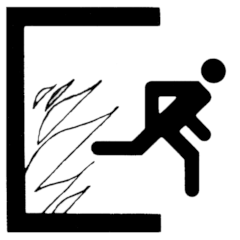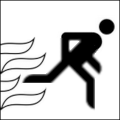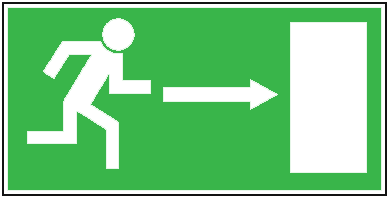Facts and data on pictograms

Since emergency exits often are not to be used as regular way out, the use of two different pictograms for Exit and Emergency Exit is essential.
An Emergency Exit leads directly out of an object or otherwise to a place of safety. It is a special exit for emergencies such as a fire: the combined use of regular and special exits allows for faster evacuation. If the regular exit is blocked for some reason the emergency exit also provides an alternative way out.
Synonyms / Other Terms Used
Emergency Egress, Escape Route, Evacuation Route, Fire Escape, Fire Exit
Category
Regulations, Directions, Safety Signs, Safety Action, Evacuation Route
Message / Function
To indicate an escape route to a place of safety
| Source | Description | |
|---|---|---|
 |
Icograda | Human figure running away from symbolic room with flames |
 |
Icograda | Human figure running away from flames towards outlined rectangle indicating door |
 |
Erco | Human figure running away from flames |
 |
BVG | Human figure running away from flames |
 |
ISO 7010 | Human figure running through doorway |
 |
92/58/EEC | Human figure running towards doorway with arrow showing in the direction of the exit |
 |
92/58/EEC | Arrow pointing towards white rectangle indicating door |
 |
AIGA | Green disk vertically bisected |
Discussion
In the studies of Collins, Lerner & Pierman (1982) as well as Collins & Lerner (1983) the AIGA variant received a very small percentage of correct answers and simply was not recognized without the benefit of prior familiarization. Already expecting this effect the authors of the AIGA symbol signs project recommended to add the appropriate word (EXIT in the U.S.) to overcome that problem.
The ICOGRADA versions shown at the top of the table reached the best scores of all variants included in the ISO 1979/80 Test Series (Easterby & Graydon, 1981), while the 92/58/EEC version with the human figure running towards a doorway received more than 40 % of insufficient responses.
In a later ISO Test Series (Brugger, 1986) conducted in five countries (Australia, Austria, Great Britain, Hungary, and Japan), the variant from ERCO could neither reach the scores of the 92/58/EEC version mentioned before nor the Japanese design by Yukio Ota (marked ISO 7010) that emerged as best variant of more than 3000 designs examined in a large Japanese study. The latter was also the best performing symbol in the experiments of Collins & Lerner (1983) that also included impaired viewing conditions.
Note: Some states/countries require that exit signs are colored red, despite the fact that the usage of color red in signage usually implies stop, danger with high risk of injury or death, and also prohibited actions, while the color green implies safe place and actions. Kinateder et al (2018) showed that egress behavior differs from verbal report: even though subjects associated red with emergency they ran towards the green marked door in a simulated fire evacuation scenario.
Recommendation
Extensive testing by various organizations in several countries showed the superiority of this pictogram (Reference No E001/E002 of ISO 7010) even under impaired viewing conditions.
This pictogram is directional and therefore has to be used accordingly (Transportation Research Board, 2015).
Tests of pictograms of referents Exit and Emergency Exit
The list below is only a small section from the wide range of studies concerning aspects of how to indicate and identify an escape route or the location of an exit.
Brugger: Ch. (1987): Evaluation of Public Information Symbols, ISO 1986 Test Series: Comprehension/Recognition Test. Vienna: ISO / TC 145 / SC 1.
Brugger: Ch. (1996): Verständnistest UIC Kodex Merkblatt 413. Report to ÖBB GD 02 (Austrian Railways), Vienna, March 1996.
Collins, B.L. & Lerner, N.D. (1982): Assessment of Fire-Safety Symbols. Human Factors, 24(1), 75-84.
Easterby, R.S. & Graydon, I.R. (1981): Evaluation of Public Information Symbols: ISO Test: 1979/80 Series. Part I: Appropriateness Ranking Tests. AP Report 99, Applied Psychology Department, University of Aston in Birmingham, January 1981.
Easterby, R.S. & Graydon, I.R. (1981): Evaluation of Public Information Symbols: ISO 1979/80 Test Series. Part II: Comprehension/Recognition Tests. AP Report 100, Applied Psychology Department, University of Aston in Birmingham, January 1981.
Gehringer, J. (1979): Untersuchung über die zeichnerische Gestaltung von Pictogrammen in Abhängigkeit von einigen Persönlichkeitsmerkmalen, sowie Überprüfung einiger Bildzeichen auf ihre Erkennbarkeit. Dissertation, Psychology Department, University of Vienna.
Kinateder, M., Warren, W.H., & Schloss, K.B. (2018). What color are emergency exit signs? Egress behavior differs from verbal report. Applied Ergonomics, Volume 75, 155-160.
Zwaga, H.J. & Boersema, T. (1983): Evaluation of a set of graphic symbols. Applied Ergonomics, 14, 1, 43-54.
See also
Updated 2023-12-21